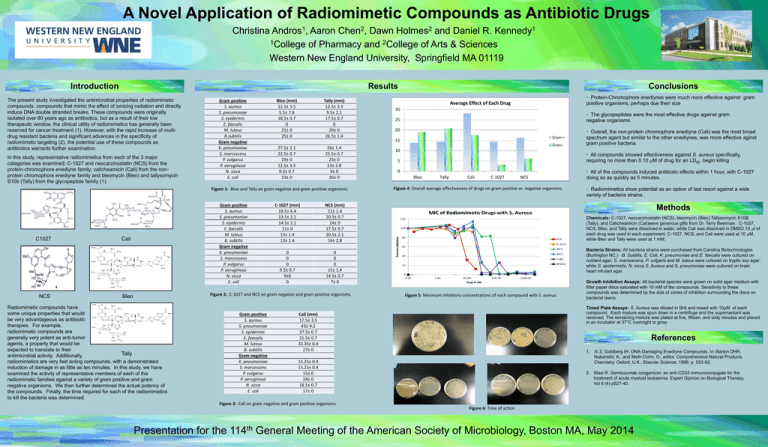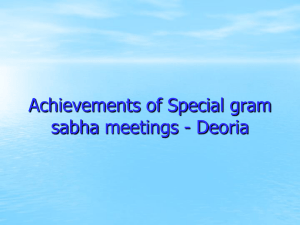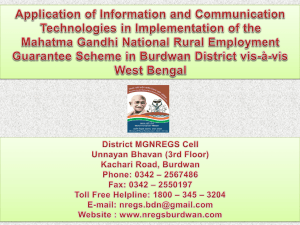ASM meeting 2014
advertisement

A Novel Application of Radiomimetic Compounds as Antibiotic Drugs Christina Andros1, Aaron Chen2, Dawn Holmes2 and Daniel R. Kennedy1 1College of Pharmacy and 2College of Arts & Sciences Western New England University, Springfield MA 01119 Introduction Results The present study investigated the antimicrobial properties of radiomimetic compounds, compounds that mimic the effect of ionizing radiation and directly induce DNA double stranded breaks. These compounds were originally isolated over 60 years ago as antibiotics, but as a result of their low therapeutic window, the clinical utility of radiomimetics has generally been reserved for cancer treatment (1). However, with the rapid increase of multidrug resistant bacteria and significant advances in the specificity of radiomimetic targeting (2), the potential use of these compounds as antibiotics warrants further examination. In this study, representative radiomimetics from each of the 3 major categories was examined; C-1027 and neocarzinostatin (NCS) from the protein-chromophore enediyne family; calicheamicin (Cali) from the nonprotein chromophore enediyne family and bleomycin (Bleo) and tallysomycin S10b (Tally) from the glycopeptide family (1). Gram positive S. aureus S. pneumoniae S. epidermis E. faecalis M. luteus B.subtilis Gram negative K. pneumoniae S. marcescens P. vulgarus P. aeruginosa N. sicca E. coli Bleo (mm) 12.5± 3.5 5.5± 7.8 18.5± 0.7 0 21± 0 25± 0 Tally (mm) 12.5± 3.5 9.5± 2.1 17.5± 0.7 0 20± 0 26.5± 1.4 27.5± 2.1 22.5± 0.7 19± 0 12.5± 3.5 9.5± 0.7 23± 0 26± 1.4 25.5± 0.7 25± 0 13± 2.8 9± 0 26± 0 Figure 1: Bleo and Tally on gram negative and gram positive organisms. C-1027 C1027 NCS NCS Cali Cali Bleo Gram positive S. aureus S. pneumoniae S. epidermis E. faecalis M. luteus B. subtilis Gram negative K. pneumoniae S. marcescens P. vulgarus P. aeruginosa N. sicca E. coli Radiomimetic compounds have some unique properties that would be very advantageous as antibiotic therapies. For example, radiomimetic compounds are generally very potent as anti-tumor agents, a property that would be expected to translate to their Tally antimicrobial activity. Additionally, radiomimetics are very fast acting compounds, with a demonstrated induction of damage in as little as ten minutes. In this study, we have examined the activity of representative members of each of the radiomimetic families against a variety of gram positive and gram negative organisms. We then further determined the actual potency of the compounds. Finally, the time required for each of the radiomimetics to kill the bacteria was determined. Gram positive S. aureus S. pneumoniae S. epidermis E. faecalis M. luteus B. subtilis Gram negative K. pneumoniae S. marcescens P. vulgarus P. aeruginosa N. sicca E. coli • Protein-Chromophore enediynes were much more effective against gram positive organisms, perhaps due their size Average Effect of Each Drug 30 • The glycopeptides were the most effective drugs against gram negative organisms. 25 20 Gram + 15 Gram - 10 • Overall, the non-protein chromophore enediyne (Cali) was the most broad spectrum agent but similar to the other enediynes, was more effective aginst gram positive bacteria. • All compounds showed effectiveness against S. aureus specifically, requiring no more than 0.10 mM of drug for an LD90. begin killing 5 0 Bleo Tally Cali C-1027 NCS Figure 4: Overall average effectiveness of drugs on gram positive vs. negative organisms. • All of the compounds induced antibiotic effects within 1 hour, with C-1027 doing so as quickly as 5 minutes. • Radiomimetics show potential as an option of last resort against a wide variety of bacteria strains. C-1027 (mm) 19.5± 6.4 13.5± 2.1 14.5± 2.1 11± 0 15± 1.4 13± 1.4 NCS (mm) 11± 1.4 20.5± 0.7 14± 0 17.5± 0.7 20.5± 2.1 14± 2.8 . 0 0 0 9.5± 0.7 9±0 0 0 0 0 15± 1.4 14.5± 0.7 7± 0 Bacteria Strains: All bacteria strains were purchased from Carolina Biotechnologies (Burlington NC.) B. Subtilis, E. Coli, K. pneumoniae and E. faecalis were cultured on nutrient agar; S. marcescens, P. vulgaris and M. luteus were cultured on tryptic soy agar; while S. epidermidis, N. sicca S. Aureus and S. pneumoniae were cultured on brain heart infused agar. Figure 2: C-1027 and NCS on gram negative and gram positive organisms. Bleo Conclusions Chemicals: C-1027, neocarzinostatin (NCS), bleomycin (Bleo) Tallysomycin S10B (Tally), and Calicheamicin (Cali)were generous gifts from Dr. Terry Beerman. C-1027, NCS, Bleo, and Tally were dissolved in water, while Cali was dissolved in DMSO.10 ml of each drug was used in each experiment. C-1027, NCS, and Cali were used at 10 mM, while Bleo and Tally were used at 1 mM. Figure 5: Minimum inhibitory concentrations of each compound with S. aureus. Growth Inhibition Assays: All bacterial species were grown on solid agar medium with filter paper discs saturated with 10 mM of the compounds. Sensitivity to these compounds was determined by the size of zones of inhibition surrounding the discs on bacterial lawns. Timed Plate Assays: S. Aureus was diluted in BHI and mixed with 10µM of each compound. Each mixture was spun down in a centrifuge and the supernantant was removed. The remaining mixture was plated at five, fifteen, and sixty minutes and placed in an incubator at 37°C overnight to grow. Cali (mm) 17.5± 3.5 43± 4.2 27.5± 0.7 21.5± 0.7 32.35± 0.4 27± 0 References 1. Xi Z, Goldberg IH. DNA-Damaging Enediyne Compounds. In: Barton DHR, Nakanishi, K., and Meth-Cohn, O., editor. Comprehensive Natural Products Chemistry. Oxford, U.K.: Elsevier Science; 1999. p. 553-92. 15.25± 0.4 15.25± 0.4 15± 0 24± 0 18.5± 0.7 17± 0 Figure 3: Cali on gram negative and gram positive organisms. Methods 2. Stasi R. Gemtuzumab ozogamicin: an anti-CD33 immunoconjugate for the treatment of acute myeloid leukaemia. Expert Opinion on Biological Therapy, Vol 8 (4) p527-40. Figure 6: Time of action Presentation for the 114th General Meeting of the American Society of Microbiology, Boston MA, May 2014







